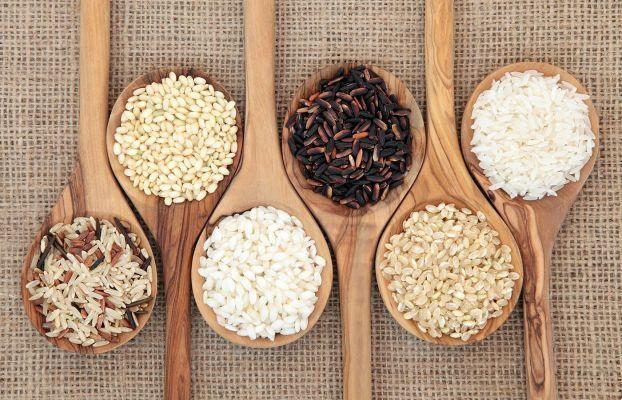
How many types of rice are there?
According to the 2021 data and statistics of Ente Risi, thehe country is the leading rice producer in the European Union, with about 50% of production.
Rice is grown in five regions of the peninsula: Piedmont - which excels, winning by about ten percentiles against Lombardy - Veneto, Emilia Romagna and, surprisingly, Sardinia.
Ci basiamo sul sito ufficiale di Ersaf Lombardia, una delle regioni in cui le risaie sono da sempre parte integrante del paesaggio, e sul sito Riso del paese per darvi un'idea di quanti tipi di riso esistano oggi in el paese: l'Oryza Sativa - this is its botanical name - in fact it has thousands of varieties in the world, but the ones that we list below are some of the types of rice most present in the area, which in total amount to about seventy.
We will limit ourselves to pointing out the main ones, summarizing the differences and specifying, underlining the fact that (source Irri) new varieties of rice are being studied that are able to adapt and cope with climate change and the direct consequences for the land and the consequent production. .
Read also Rice for insomnia, 4 recipes >>
Types of rice: how to choose among many grains
> Arborio: long and semi-round grain, of excellent quality, born in the Vercelli area. With a low percentage of amylose, it is suitable for risottos and guarantees excellent creaming. Appetizers, timbales, side dishes or single dishes still want it as the protagonist. It is not suitable for the preparation of desserts. It cooks boiled in 16 minutes, for the risotto it takes 17.
> Baldo: With a long grain and semi-tapered, the baldo is a variety of the historical IGP landscape of the Po delta. It is used for less demanding risottos and for rice salads. Not recommended for sweets. It cooks boiled in 15 minutes, for the risotto it takes 17.
> Carnaroli: long and tapered grain rice, with a high percentage of amylose, is considered the "prince of rice". Born in Lombardy, it is excellent for thick risotto and rice salads; not recommended for desserts as it is not sufficiently sticky and pasty. It cooks in 16 minutes for the boiled rice, in 18 minutes for the risotto.
> Padano: medium and semi-round grain, does not have a good cooking resistance; Padano rice is a simple rice, ideal in soups, broths or minestrone, and also in timbales and other baked preparations. It is also consumed in white, enriched with sauces, meat sauce or vegetable dips. It cooks in 15 minutes.
> Fish: it is a long rice perfect for timbales, arancini, fillings and supplì, being a rice that loses a lot of starch and therefore becomes very sticky during cooking. It cooks in 17 minutes, 15 for the simple boiling.
> Roma: it has a long, semi-tapered grain, similar to the Baldo, but pearly. It goes well with sauces and, by absorbing the ingredients well, it can be ideal for risotto with vegetables, white rice, with sauce or accompanied by sauces, for timbales and flans. It cooks in 16 minutes if boiled, for the risotto it takes an extra minute.
> Rosa Marchetti: semi-long grain, it is an almost transparent rice. This is also born in the Vercelli area and is excellent for timbales, sweet cakes and for soups and soups. He does not mind risotto. It cooks in 17 minutes, 16 for the boiled rice.
> Sant'Andrea: with a long and semi-tapered grain, it is typical of the Biella and Vercelli areas. It has an excellent cooking resistance, which makes it ideal for soups, soups, but also for simple risottos. With this rice we make the typical "panissa", the rice and beans from Vercelli. It takes 16 minutes for the risotto, 14 for the boiled rice.
> Vialone Nano: variety with a semi-long and rounded grain, it is produced in Veneto, where it obtained the PGI and in the Mantua area. Rice is perfect for simple and peasant risotto ideal for the famous Venetian dish "risi e bisi", rice with peas. It takes 17 minutes to cook the risotto, 16 minutes for the boiled rice.
Thaibonnet, Balilla, Venere, Perla, marte, Gemini, Brio, Eurosis, Mercurio, Orione, Poseidone, Oceano, Carnaval, Sole, Ribaldo, Sirio, Allegro, Genrale, Cleopatra, Lagostino... Ecco qualche altro nome di risi meno comuni, che rientrano comunque tra le numerossissime varietà che spesso escono anche dal mercato del paese.
Recommended reading:
> Technical information on the website Ente Risi Ente Nazionale Risi;
> "3000 grains of rice", a book written by Alberto Girotto which is a world tour in 200 rice-based recipes.
Chinese proverb: "Eat your rice, heaven will take care of the rest"
Photo: nopsang / 123RF Stock Photo
Read also Rice salad, a healthy dish >>


























